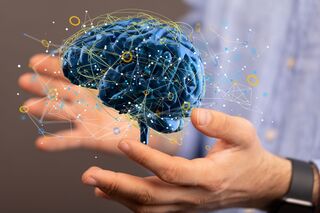Towards Artificial General Intelligence

Of course, there is no way a machine can feel and experience thoughts like a
human, but it can compute and relate concepts, and encode human-like experience
(e.g., a snake is dangerous and scary, therefore it must be avoided). So, what
might be the solution in developing such relational networks, which could bring
about a general form of AI called artificial general intelligence (AGI), which
could 'think' like a human and in the way which was proposed in Dartmouth
College in 1956? Simply more parameters in a neural network? Recent work
conducted in my own lab with colleagues in Belgium has suggested that a new
approach of functional contextualism (which differs from current forms of
cognitivism — e.g., of memory, attention, and reasoning through logic) may be
the solution to progress AI into the generalized form of AGI, where the system
learns and understands concepts and how these relate to other concepts (through
something called relational frames), and the context in which cues within the
environment influence functions and the meaning or uses of such
concepts.
The Shape of Things to Come: GraphQL and the Web of APIs

The inflection point for GraphQL, however, is still a ways off. While there are
some major companies using GraphQL, such as Shopify, REST is still the most-used
API format in many other companies — including prominent API-based public
companies Stripe and Twilio. I asked Jhingran whether he sees those types of
companies pivoting to GraphQL over time? He first noted that he doesn’t see
GraphQL usurping REST. “We typically find that the REST layer that enterprises
have built, [they] have embedded business logic into it. And the GraphQL there,
in general, will be a composition layer — as opposed to incorporating deep
business logic. And therefore, both will actually co-exist.” However, Jhingran
does think that more and more companies will start using GraphQL for their
external services, a trend that will happen in stages. “Backend teams are
becoming comfortable with GraphQL for the apps that are built by the team,” he
said, meaning applications developed internally. Backend developers will take
more time to get comfortable using GraphQL APIs from third-party companies,
although Jhingran pointed to GitHub and Shopify’s GraphQL APIs as early
examples.
Stanford cryptography researchers are building Espresso, a privacy-focused blockchain

Espresso Systems, the company behind the blockchain project, is led by Fisch,
chief operating officer Charles Lu and chief scientist Benedikt Bünz,
collaborators at Stanford who have each worked on other high-profile web3
projects, including the anonymity-focused Monero blockchain and BitTorrent
co-founder Bram Cohen’s Chia. They’ve teamed up with chief strategy officer Jill
Gunter, a former crypto investor at Slow Ventures who is the fourth Espresso
Systems co-founder, to take their blockchain and associated products to market.
To achieve greater throughput, Espresso uses ZK-Rollups, a solution based on
zero-knowledge proofs that allow transactions to be processed off-chain.
ZK-Rollups consolidate multiple transactions into a single, easily verifiable
proof, thus reducing the bandwidth and computational load on the consensus
protocol. The method has already gained popularity on the Ethereum blockchain
through scaling solution providers like StarkWare and zkSync, according to
Fisch. At the core of Espresso’s strategy, though, is a focus on privacy and
decentralization.
5 Tips on Managing a Remote-first Development Team
Working from home makes it harder to remain connected with team members and
stakeholders as it reduces not only the frequency of our communication but also
its quality. We tend to rely more on email and instant messaging, both purely
written media (if you exclude the occasional GIF). How can we, as managers and
leaders, ensure that we are fostering healthy and effective communication in our
teams and with our stakeholders? Meet 1o1 often and effectively. Unfortunately,
one of the first casualties of working remotely tends to be 1o1 meetings. Most
managers, particularly early career ones, have difficulties leading good 1o1s.
Engineers seem to be particularly averse to bad meetings, seeing them as
distractions or as waste of time. This also applies to stakeholders, making
addressing concerns, conveying important updates or solving project constraints
more difficult. The importance of 1o1 meetings cannot be understated. In its
famous Project Oxygen, Google found that managers with higher feedback scores
also tended to have more frequent and higher quality 1o1 meetings with their
teams.
Blockchain and GDPR (General Data Protection Regulation)

The most obvious method to sidestep the GDPR is simply not to put any individual
data on the blockchain relating to any private citizen or resident of the EU.
However, this drastically reduces the usefulness of blockchains for any public
application, such as health record tracking, social media, reputation reporting
systems associated with online sales, and identity systems such as an
international passport. The GDPR does not specify if subsequent corrections to
the data are acceptable, if the original incorrect data is still present in
earlier blocks on the blockchain. ... A further possibility is to ensure that
all private data stored on the blockchain is encrypted. In such a situation, the
company responsible for data care can provide evidence of the deletion of the
data by ensuring that the decryption key is destroyed. Another approach may be
to shift the responsibility for protecting the private key to the individual
whose data is being stored on the blockchain.
IT talent: 3 tips to kickstart employee career development

Training typically focuses on hard skills, which is not surprising for a
technical role, but it is critical to understand the importance of soft skill
training for IT professionals. Soft skills are particularly essential amidst
digital transformation efforts, which cannot be done in a silo and require
strong communication among many departments. I recently had the opportunity to
participate in an eye-opening leadership course on driving strategic growth,
which reinforced for me how important it is to take the time to build and
strengthen soft skills. This course ran over three months and consisted of
lectures, formal learning, and time to practice. Ultimately, we returned to
the larger group to share learnings from our practice time. This learning
process reminded me how important it is to build learning programs around soft
skills. While teaching soft skills can require time and effort, incorporating
them into skills training can positively impact your IT employees’ experience
and set them on a path of growth and development.
Indian govt kicks off the consultation process to build a fairness assessment framework for AI/ML systems

“We have been studying various aspects of AI/ ML where some standardisation
or testing and certification framework could be established. Moreover, we
have studied the works of various researchers where biases in various AI/ ML
systems deployed by leading corporates and governments are deliberated.
Biases in AI/ ML Systems are a real threat, and ensuring fairness in such
applications is very important to build public trust in AI/ ML Systems.
Accordingly, we have initiated discussions for evolving a framework for
fairness certification of such systems,” said Avinash Agarwal, DDG,
Telecommunication Engineering Centre. TEC aims to set up standard operating
procedures (SOP) to assess the fairness of various AI/ ML systems and create
a benchmark. Systems that conform to the specifications will be given a
fairness certification, ensuring product credibility and public trust in AI/
ML. “To achieve this, we will follow a consultative process for framing
standards, specifications and test schedules. Then, we plan to prepare a
draft document based on the various inputs received and release it for
public consultations.
SOARs vs. No-Code Security Automation: The Case for Both

This is not to say that you’re required to ditch your SOAR and replace it
with a lightweight security automation platform like Torq. Many businesses
that have dedicated cybersecurity teams may opt to continue to use their
SOARs as the place where they detect and manage the most complex threats,
such as active, targeted attacks by professional threat actors. But for
managing more mundane risks — like blocking phishing emails, securing
sensitive data or detecting malicious users — lightweight no-code security
automation is a more practical solution. It’s much easier to deploy, and it
empowers all stakeholders to support security operations, even at
organizations that have minimal cybersecurity resources. By extension,
no-code security automation is the key to thriving in the face of today’s
pervasive threats. When you operate in a world that sees 26,000 DDoS attacks
and 4,000 ransomware attacks each day, and where threat actors are
constantly probing your systems for an open door, you need more agility and
automated remediation than a SOAR alone can deliver.
Closing the data quality gap

Data agility has become a central pillar of building a supple business, one
that can move, and pivot quickly as new information arises. In the simplest
terms, data agility is the distance between the data that informs a decision
and the decision itself. This means that poor quality data will lead to poor
decision making. Pairing trustworthy contact data with an agile data
management programme enables organisations to make their data actionable,
allowing for better and faster decisions when pursuing new and existing
opportunities. That’s why 94% of business leaders believe having agility in
both business and data practices is important in responding to the pandemic.
Achieving greater agility requires business leaders to rethink their use of
technology and be more open to integrating it into their businesses. Half
the human brain is devoted to processing visual images and processes data at
60 bits per second. That might go some way to explain why four out of 10
leaders say they are looking for easy-to-use solutions; in turn this helps
enable data and business users alike to visualise, read, write, and argue
with data insights.
Digesting Blockchain

The servers are located in different computers around the network, therefore
being distributed (peer-to-peer or P2P). Once a transaction is made, the new
information is replicated and received by the nodes within the P2P network
and added to the corresponding block open at that time. The block will
contain the transaction information and each transaction will be assigned a
"hash" once it has been validated by the network nodes —the cryptographic
hash is like the digital fingerprint of the transaction and is represented
by a sequence of numbers. A hash is a function that converts one value into
another, and the latter contains a fixed amount of numbers or figures. The
information about the transaction recorded in the block can include details
regarding who, what, how, how much, or when the transaction happened. The
information contained in the block can neither be changed nor its hash.
Accordingly, If the information in a block is changed the whole sequence of
blocks will become invalid.
Quote for the day:
"The test we must set for ourselves
is not to march alone but to march in such a way that others will wish to
join us." -- Hubert Humphrey
No comments:
Post a Comment